Classic Philips and Marantz CD Player Comparison – part 1
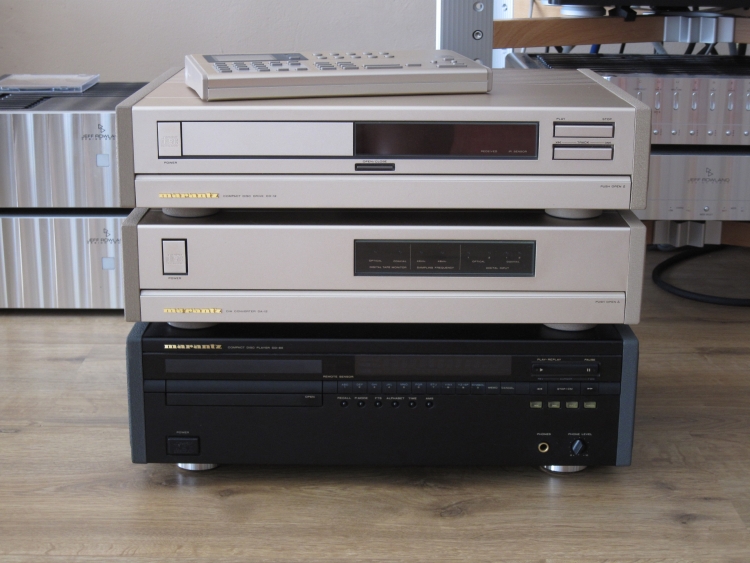
These oldies perform way beyond expectation and even have some special qualities that are rare in digital!
Amongst these high-end digital components, there are still 2 classic cd players in the racks, with good reason: even in the company of the CEC super transport and dcs converters they aren’t entirely beaten.
Especially the Marantz CD94MKII is very seductive: already very good when used as an integrated player (without external DA converter), but almost unbeatable when used as a transport.
In this extensive comparison, you can read all about various classic Philips and Marantz cd players, compared to each other as well as to a reference CEC transport and reference dCS digital components. The players are used both in an integrated manner and as a transport, feeding an external DAC.
All players were compared under identical circumstances, well-warmed up and run in, powered with the same phase, using the same powercords when possible, positioned in the same audiorack, with the same interlinks etc. They were originally compared in this setup and it was in this setup that they had to compete with established high-end reference components such as dCS Delius/Purcell, Audiomeca Mephisto 2/Enkianthus and CEC TL1-x. In the following years after the initial review was written, more and more players were added. These later additions were reviewed in this setup.
A small disclaimer is probably in order as the age of these players varies and some of them are even 20 years old at the time of review. Even though I have listened to more than one player for many models, some players may have been worn out slightly, which can have had an affect on the sound quality. Therefore the results may not be entirely objective for all models.
All the reviewed players at a glance
The Philips players:
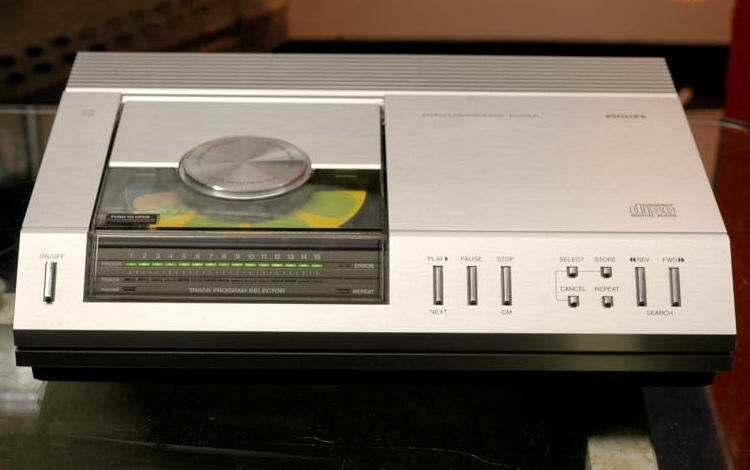
Philips CD100
1983. CDM-0 or CDM-1 transport, TDA1540 DAC. The first commercial cdplayer ever. The CD100 was the simplest Philips player at the time. A little later there were also the CD202 and CD303. Sadly I couldn’t listen to the CD100 in this group test because it has stopped working. I have heard him longer ago in a friend’s setup and I suspect that it sounds a lot like the CD104 that I did listen to in the context of this test.
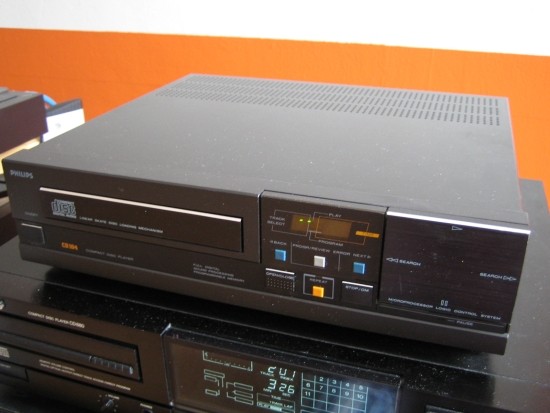
Philips CD104
1983. CDM-1 transport, TDA1540 DAC. Entire chassis is made of cast zinc and it is very heavy for such a small player (7 kilo). Its dac can only output 14 bits but despite this (and probably thanks to the oversampling, invented to make up for the bit loss) it nevertheless sounds very refined. The 104 is never less than smooth, warm and musical which benefits badly recorded cd’s enormously. Compared to better players it does lack drive, slam, detail and speed.
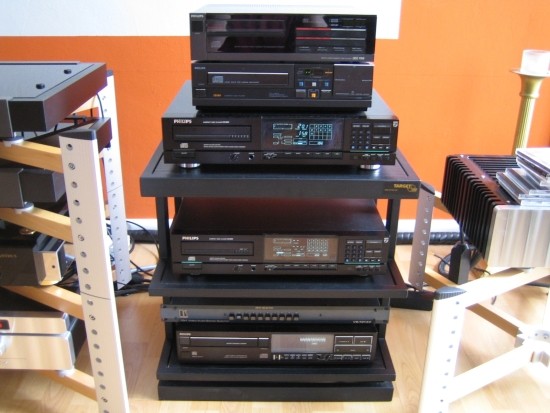
Philips CD150
1985. CDM-2 transport, TDA1540 DAC. Has exactly the same dimensions as the CD104 but has been produced in a low-cost fashion, meaning that almost everything that was cast zinc or metal in the 104 is now plastic. Even the transport is mainly from plastic! The sound is sadly likewise: synthetic and plasticky. For me this player performs way below par and it will be excluded from further comparisons.
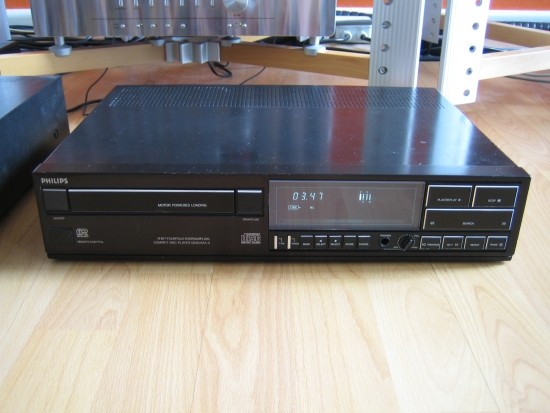
Philips CD304MKII
Around 1986. CDM-1 transport, TDA1541 DAC. Sounds like a hot-rodded CD104, is in fact more akin to a CD304, now with a better interface and all of the 16 bits. Retail price around 800 euro. Compared to the CD104 sounds a lot fuller and more dynamic but the midrange has a certain shoutiness and although the 304 is nicely enthusiastic and has lots of drive (especially in the bass, call it PRAT) it als sound less relaxed and less smooth than the other players in this test.
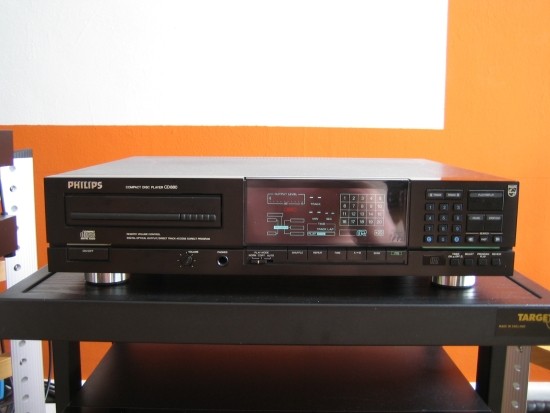
Philips CD880
1988. CDM-1 Mk2 transport, TDA1541S1 DAC. Soundwise completely different from the 304MKII: much airier, more spacious, more subtle, more refined, more transparent yet lacking the 304MKII’s all-out drive and slam. The 880 is always well-behaved. You could feel that the is 880 too refined for its own good but when judged on its merits it is simply almost unbeatable. Using its digital output into the DCS combo, it produced extremely refined audiophile results, beaten only by the CD94MKII.
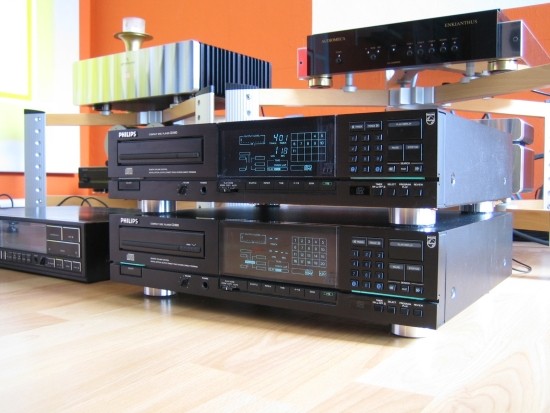
Philips CD880 USA
1988. CDM-1 Mk2 transport, TDA1541S1 DAC. 110 volt-version of the 880 Europe, used here with an extra step-down transformer. This extra transformer is most likely the cause of this model’s very different sonic signature compared to the 880 Europe. The USA version sounds smoother, fuller and more fluid but at the expense of some openness and airiness. You could call the USA version cozier and the Europe version more precise.
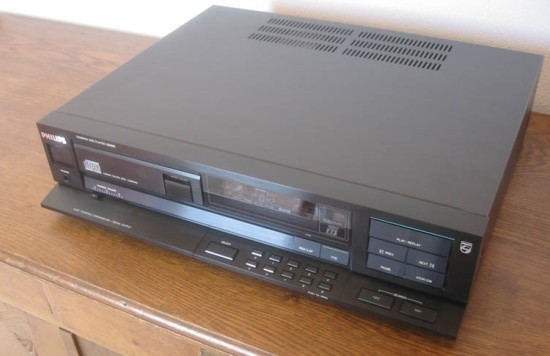
Philips CD960
1987. CDM-1 transport, TDA1541 DAC. According to many, this is the best Philips of its time. Newprice approx 1000 euro. Inside it has many similarities with the Marantz CD94MKII and also sounds pretty similar, but there are differences. It is less subtle and has less transparency than the CD94MKII but it does sound a little more lively. In fact: it sounds a lot like the CD94 (MK1) which is internally identical. Note: this CD960 has an upgraded DAC-chip: from TDA1541 to TDA1541A silver crown. The CD94MKII has dual silver crown DACs.
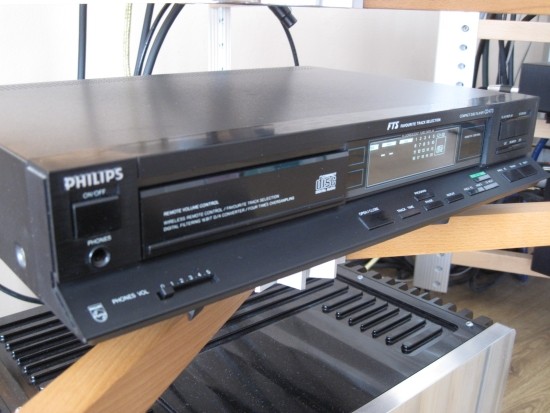
Philips CD473
Added in 2012 after the extensive review was written – not included in overall comparisons
1988. New around 400 euro. CDM-4/11 (“composite” read plastic) transport, TDA1541 DAC. Like the CD624, this one is almost 100% plastic. You got to admire the extent to which the manufacturer goes in order to keep the price low, while maintaining what is basically a fine sound. The CD473 isn’t the best Philips there was, but it doesn’t sound as synthetic as the CD150 did. Like all swing-arm/TDA1541 equipped players, it sounds full and smooth in the bass, creamy in the midrange and fluid in treble. Yet it is a bit fat and full and lacks the CD94MKII’s precision and refinement and the CD84’s unbridled enthusiasm. Not the best, but not bad at all.
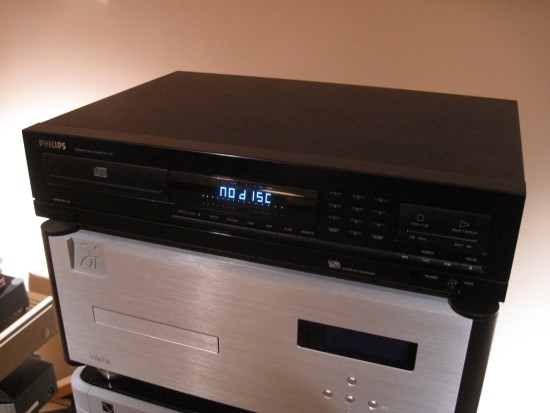
Philips CD732
Added in 2012 after the extensive review was written – not included in overall comparisons
1993. CDM-12.1 transport, Bitstream DAC (version TBC). Not even half-filled on the inside, with a simple transport and even simpler output stage, still this player sounds mightily entertaining. It isn’t the smoothest or most colorful around, nor does it have the swing-arm-typical fluidity and refinement in the treble, but it makes up for this with a full and rhythmic bass and unbridled enthusiasm while avoiding to sound synthetic.
Philips CD732 with modifications: after the owner replaced many capacitors inside, the soundstage grew enormously, also layering and focus within the soundstage was all of a sudden almost on a par with the Levinson 390S, and even though it didn’t become a CD850, it also did gain some color. Not the most emotional/dreamy player here, but with or without these mods, this is the neutral player to beat.
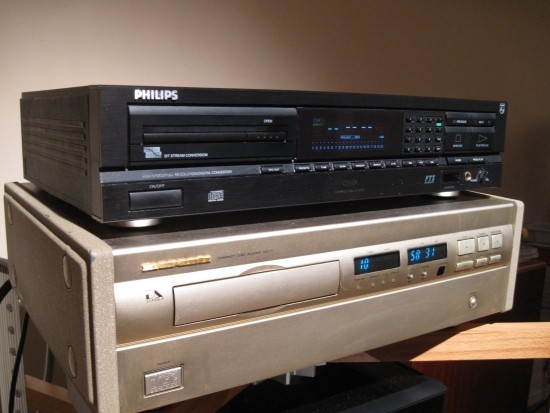
Philips CD624
Added in 2012 after the extensive review was written – not included in overall comparisons
1991. CDM-4/19 transport, SAA7323 Bitstream DAC. Whether or not it is due to the swing-arm mech inside or not, even though this was originally a cheap player, just like the other swing-arm mech-equipped players this one sounds ultra fluid, super supple and ever-so refined. It does lack color, bass drive and overall fullness. It is quite thin and sounds a bit synthetic with some music. The CD850 could be regarded as a better CD624 but it’s not just better: it shreds the CD624 to pieces!
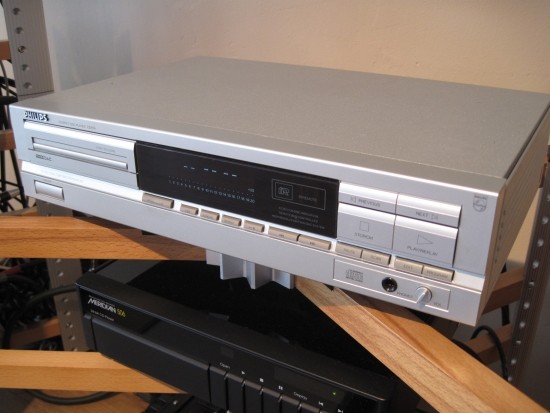
Philips CD614
Added in 2012 after the extensive review was written – not included in overall comparisons
1991. New around 300 euro. CDM-4/19 (“composite” read plastic) transport, Dual TDA1543 DAC, which is somewhat like a miniature TDA1541. Again here is a 99% plastic super-lightweight player but it packs a swing arm mechanism and makes surprisingly refined sounds. In fact, this player sounds so very fine that I can listen to it all day without feeling like I’m missing anything other than the bass, which is decidedly thin and lacks power and punch. Apart from the thin bass and being somewhat less than lifelike, this is a very fluid and delicately detailed player. It can also easily be upgraded by sticking Vibraflex vibration reduction sheets anywhere where there’s space and disconnecting the headphone output. This makes the player sound fuller, more dynamic and more solid and you will love its sound, until you start comparing to dearer models such as the CD94MKII and the CD11LE. Soundwise (with mods), despite multibit dac, I’d place it closer to the CD624, CD951 and partially the CD11 than the CD94 and all other older multibit players. It’s a real nice balance of the classic sound and a more modern sound, of subtlety and musicality. Especially with damping pads applied, IEC inlet installed and headphones disconnected it sounds much more solid and colorful and really becomes THE cheap player to have.
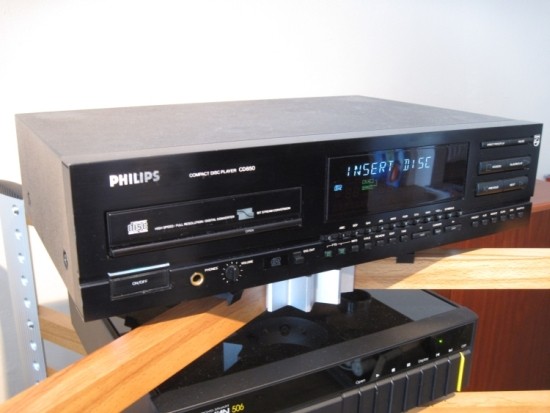
Philips CD850
Added in 2012 after the extensive review was written – not included in overall comparisons
1991, CDM4/19, 2x SAA7321GP. Even though internally this is sort of a better CD624, with same build but more components, this one really surprised me with its super creamy-smooth-luscious midrange and super-silky treble. Bass is big and deep and the soundstage is XXL. This is luxuriousness like I only know it from the CD94, and this is in stock form – no mods! Despite its smoothness and almost loudness-like character, it is very detailed and well-paced. It just never shouts and doesn’t do aggression, ever.
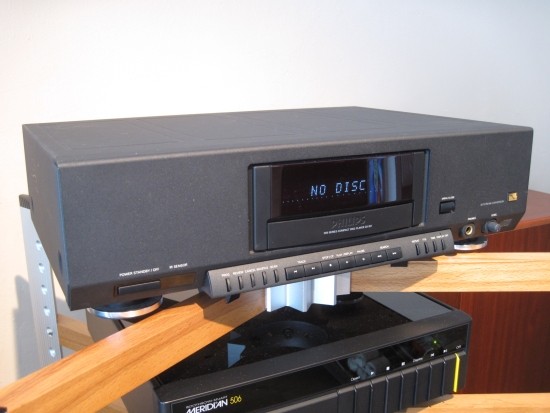
Philips CD951
Added in 2012 after the extensive review was written – not included in overall comparisons
1994. 700 euro new. CDM-9/65 transport, TDA1547 Bitstream DAC. Top of this Philips range at the time, priced accordingly. Inside there’s plenty of space but there’s a nicely laid out, large circuit board packed exclusively with full-size discrete components, no SMD, although the output devices are opamps. By default this player has some tweaks such as damping pads in various places, a power filter and a soft damping ring for the crystal oscillator. This player sounds very confident and upbeat, while retaining all the refinement, fluidity and airiness that I always associate with swing arm mechanisms. It has deep, quick, articulate bass but doesn’t have all the color or full character of the best players here and can sometimes sound a little bit too controlled/accurate, rendering it a less emotional listen.

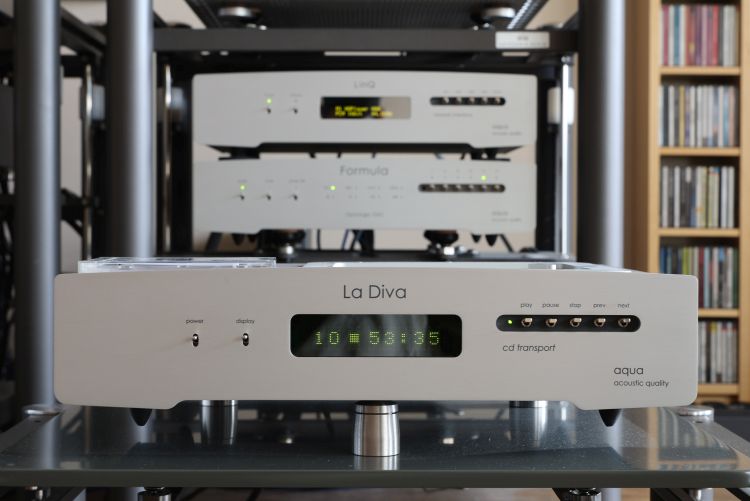
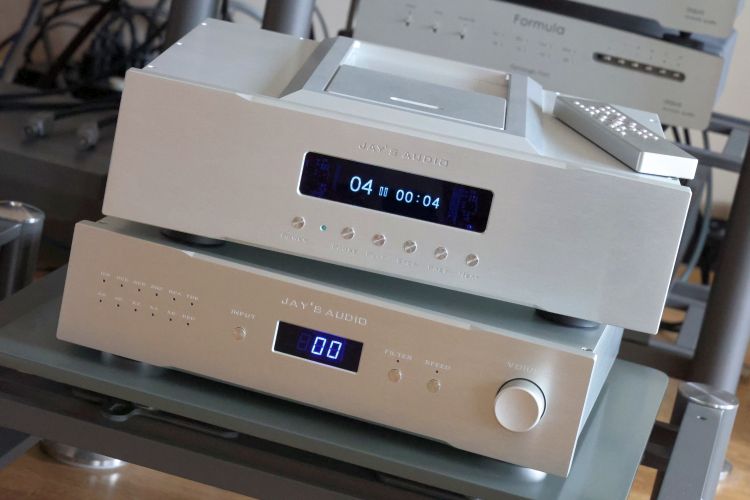
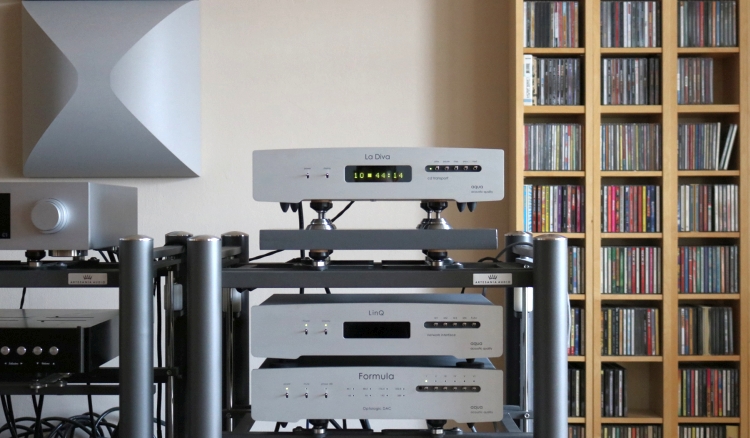
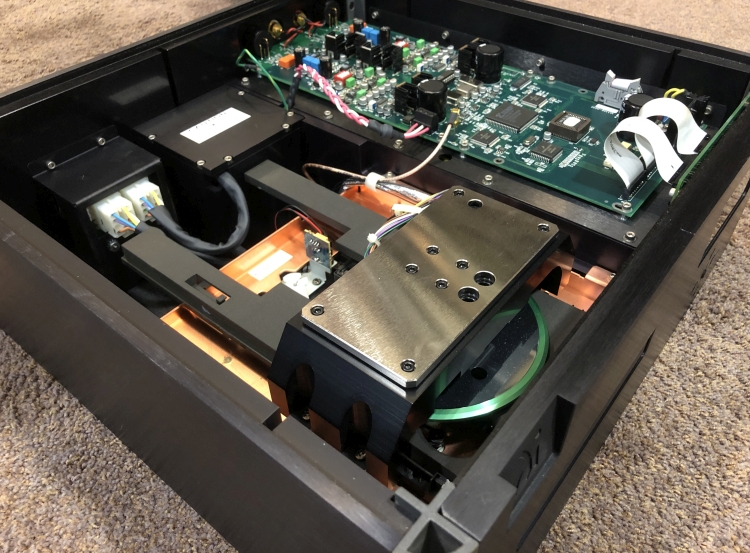
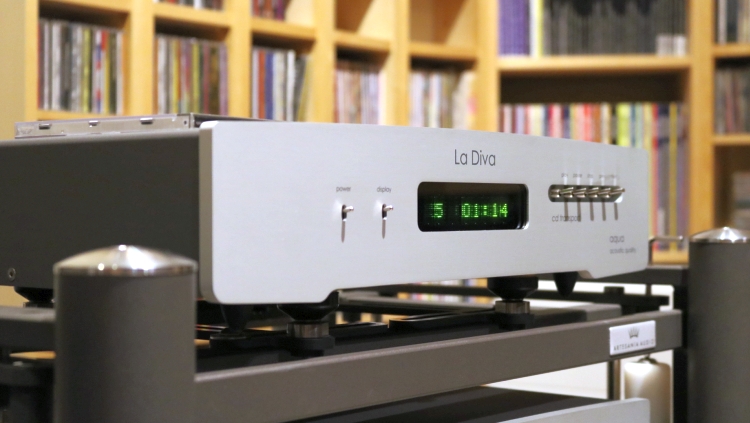
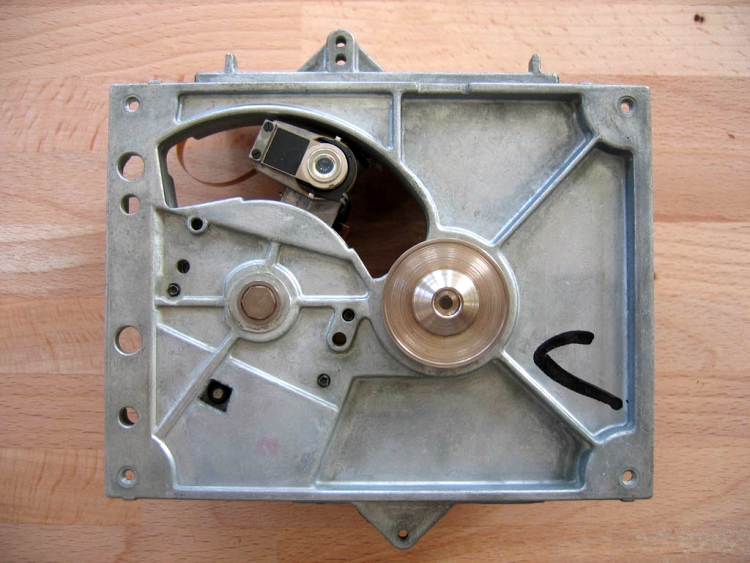
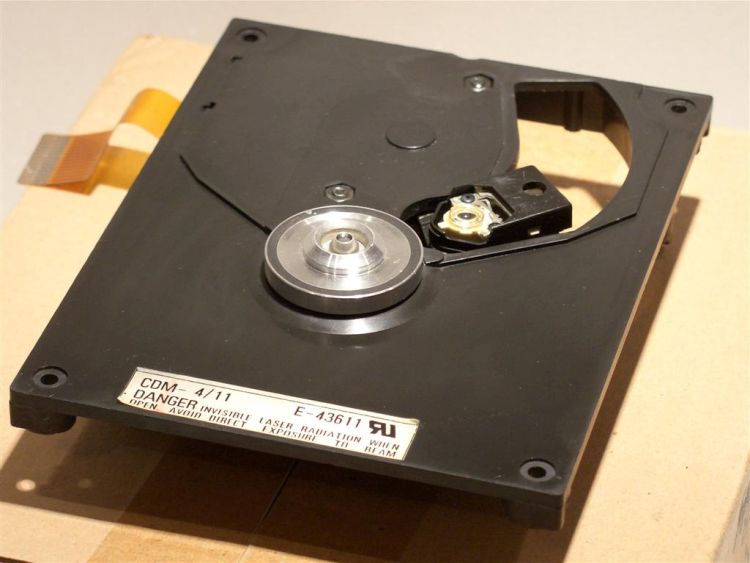
Hello Christiaan, an avid reader of your site here. I kindly ask for your advice on something. I intend to buy a top vintage cd player and I have the following options:
Philips CD960, Philips CD880, Pioneer PD-77, Sony XA50ES, Sony X77ES.
I know that you already tested some of these models, that is why I am asking: which one from these do you think has the best overall sound and it is better value? My most important criterion is minimum digital glare.
Thank you!
If by glare you mean harshness or brightness then the Philips transport players are a better option because they sound much smoother, creamy even if they’re nice and aged. The Pioneer is nice, but its transport is unobtainium so I wouldn’t risk it. Between 960 and 880 you may prefer the 960 for its fuller sound but it is also more expensive and you may just as well get a Marantz CD94. For more info I really must point you back to the review where I describe the differences in lots of detail.
Yes, traces of bright and synthetic sound is what I want to avoid the most. I have three vintage players, Sony X55ES, Philips CD950 and Philips CD303. The Sony sounds big and dynamic, with a larger than life soundstage, but I find it bright and somewhat plasticky sounding. Too digital, if you will. Philps CD950 is more correct, with lots of details but I don’t know, it is rather uninvolving, it doesn’t draw me to the music, it doesn’t say anything, it doesn’t speak to me, so to put it. CD303 is very involving and natural, but I feel that I am missing a lot of detail and air. This is why I want to go up the ladder and get one of the models I asked you about.
Thank you for answering!
Indeed these Sony’s sound synthetic in a wat that the Marantz/Phlips players do not. CD950 is no favorite of mine, it is still a little synthetic and lacks power and dynamics. If you like the 303 then you should try a CD94. Same signature, more detailed. 880 might also be an option if you want maximum air and don’t need the bass/lower midrange fulness. A Merdidian 506.24 is also very nice btw.
Merci
Hello Christian.
thank you for your feedback and your advice.
I like it so much that I think to associate him a DAC ……. but to decide it is the jungle.
I listen mainly to CD but I would also be able to connect a PC to try someday the dematerialization.
I like the analog typed more than the digital sometimes very accurate but not singing.
more emotion than precision.
Do you have from your experience models DAC a little “old” to find them in occasion. My maximum budget would be 500 euro.
Or is it wiser to find a meridian at the same price ???
Thank you.
Samuel
Bonjour,
J’ai découvert votre site et notamment ce reportage sur les platines cd Philips parce que j’ai récupéré une vieille Philips cd614 .
Je voulais savoir comment elle sonnait et quelle surprise !!!
Ça sonne super en tout cas avec mon système (enceinte altec)
du coup je suis devenue curieux de ces “vielles platine”.
Et donc je peux avoir une CD 834 Philips pour pas trop cher.
que vaux t’elle ?
j’aime beaucoup ma 614 et comme vous dites à part un grave léger le reste est très fluide et raffinée.
elle rempli la pièces avec aisance.
un peu plus de “peps “sur la bas de spectre et c’est bingo.
Du coup je n’ecoute presque plus ma Gold note CD-7 qui parait bien fade a coté de la philips. !!
Bravo pour ce reportage fort intéressant.
Simple as it is, the 614 really has a very appealing sound indeed. In part this is due to its CDM4 mechanism but also in part due to its multibit DAC. While I have not heard the 834, I have actually heard and still own the 624 as well as a bunch of 614’s. The 614s have multibit DACs but the 624 and the 834 also are bitstream designs. Comparing the 624 to the 614’s and I much prefer the 614s. I would expect the 834 to sound much like the 624 and so I would not try it unless you can get it really cheap.
Hi Samuel,
don’t know if it’s still nice to know…
I have a CD614, too. Quite weak in bass reproduction which is similar to my CD630, although three times more expensive.
After removing the digital filter for non-oversampling in the CD630 I was surprised about the powerful bass. Maybe, non-oversampling in CD614 will have the same effect…? 🙂
The 614’s main problem is its power supply. In order to get tighter and more powerful bass it should be 1. recapped (Panasonic FC, mostly), 2. get a beefier transformer, 3. get dedicated regulation modules for its various stages (Ali is your friend), 4. get a better clock (Tent). That will all help a lot. Then, the mods you do to its filter will have so much more effect. The beauty is that its heart, the CDM4, (when recapped) is already as good as it gets and seems to last forever. I’m sorry but I can’t share any details on the precise steps to take, there are just too many and they’re all relative and require lots of ifs and buts. I am working on an article as I go along but it’s already 5 times as long as other articles and I doubt that I will find the time to edit it properly so that it is fit for publication…
Thanks for your tips, Christiaan!
I’m really impressed with how long caps last in CD players with Philips technology. It seems that age is not a problem, but rather the “working hours” that have passed.
My CD650 needed new caps on the CDM 2/10 board to be able to sample the last tracks on long CDs again. My CD630 got new caps together with the non-oversampling. Nevertheless, my CD614 sounded very good but weak in bass when I bought it in 1991 or 1992. In comparison my AKAI CD-55 was more powerful at that time.
The power supply in the CD614 is similar to that in the CD630. So it’s quite possible that new and better caps will also improve the CD614. I already read your article comparing your CD614 with the modified one of your friend. Maybe I will make these changes too. 🙂
The CDM 4/19 is obviously the most reliable of all CDMs. But I had to buy the CD614 for € 10 gear and belt. And although I’m not a mechanic or technician, I replaced it myself within 30 minutes. Hurray!
I am very curious about your detailed article but also patient. Don’t worry, don’t hurry! 🙂
Indeed, the caps seem to last forever. However, they are not the best quality to start with and even if the player still works, chances are that they have gone off spec. Like old Quad amps, the design is clearly very cleverly done in such a way that aging goes very gracefully and does not cause malfunction prematurely but the units do start sounding softer and softer as they age. BTW: different caps also have different sound and the Panasonic FC’s are the best that I heard for these players so far. BTW 2: I recently purchased a NOS CD614, new in the box! It works perfecly except for, of course, the drawer wheel which desintegrated after 5 rotations:-) If only the wheel fails, you really have to appreciate the thought that has gone into making these plastic unibody players so simple yet so effective, right?
However, even this new sample had the familiar softness in the bass, just as you noticed with your unit. The existing 614 article is a great start for integrated players. My current quest is for making a superb transport by removing any analog circuitry (that alone already much improves the sound of the transport), adding the aforementioned upgrades and now I am experimenting to find the best output interface. I don’t want to dive too deeply here as I know I can’t stop myself once I get started and I really need to crack on with reviews but I can tell you that the best of my modded Philips 614 transports outperforms pretty much anything I put up against it. I had hoped to round this project off long ago but as I go along together with an audio buddy who has tireless component-searching capabilities, I keep finding new focus points. And so long as the adventure keeps going, the article cannot be made… Oh well…
Soooo damn right! A simple plastic wheel for a few pennies… but isn’t that expectable for a 155 Euro device? Otherwise, if every other part in the CD614 is unbreakable and durable… suspicious, eh? 😉
Congrats for the NOS! Guess the CD614 will sound amazingly after the other modifications you described.
I don’t miss the lack of bass in this player anyway. A good Amp is able to stand in for it. Moreover, the precision in reproducing a real stereo ambience my very personal preference. Considering this, the CD614 can nearly keep up with far more expensive players of the same age like the YAMAHA CDX-1050.
I’m really adoring your enthusiasm and look forward to your upcoming reviews and projects. 🙂
Good to hear, Heiko!
Hi Samuel, if you’re looking for that smooth, relaxed and fluid sound but want to improve on this while retaining the character, and stay under 500 euro then I would suggest trying a Meridian 506.24 CD player. Adding a Meridian DAC in my experience does not bring the same level of improvement.
Great review! I have been following the history of Philips CD players since 1982. During my studies I bought the Philips CD960. I still own it. What a wonderful piece of equipment. Recently, the loading mechanism stopped working. So I need to change the belts. Does anyone know about a good description how to perform this task? In the meantime, I use a Philips SACD-Player (DVP720SA) from 2003 and a Sony CDP-S1 from 1995. Both are good players which can be bought at very low prices on eBay.
Please add more Philips/Marantz CD-, DVD- and SACD-Players to your review. THanks.
Rene
Hi Rene, changing the drawer belts is quite tricky. I’ve not done it myself but you should be able to get instructions from the service manual.
Hi Audiophiles,
recently, I added a SONY CDP-997 to my collection and had my PHILIPS CD630 in revision including setting it to non-oversampling.
Both players are better consumer devices but with a significant difference. After NOS modification, the CD630 (also released as CD830 – only god knows why) with TDA1541A with CDM4/19 got substance! Detailed and someway analytic by origin, this CDP sounds way fuller and warmer now. Last but not least the NOS widens the sound stage remarkably.
In comparison, the SONY CDP-997 sounds somehow industrial as if engineers tried to push sound quality to 110 percent. Nevertheless and as it fits as a glove, I prefer the SONY for any Phil Collins songs.
For anyone who’s interested in which brand is better I’d recommend all TDA-based players. I know that there are a few SONY CDPs having TDAs inside. Could be a compromise…? 😉
Moreover, with TDA154x DACs you still have the opportunity to replace the digital filter with NOS-PCBs. Test it for a little money! 🙂
Regards,
Heiko
hello Christiaan,
thank you for your analysis on all these devices. Passionate.
I was marked by the analysis of the PHILIPS CD850. This is the sound I am looking for. Have you listened to the CD850 MK2. What’s your opinion ? Does it also have XXL bass, creamy midrange, and silky highs?
Thank you very much Christiaan
Best regards
Christian
Hi Christian, you should know that, at the time of the original comparisons, I paid no attention to the state of the capacitors. Since the players were at that time already pretty old, my assessments should be taken with a grain of salt. For instance, when a player has gone off-spec it will sound rounder, sweeter, smoother and indeed creamier, which can all be nice but the sound will also lack focus which will be particularly noticeable in the bass by a measure of blur and a lack of speed and drive. To some extent, I know now that the big bass that I heard with some players, is the result of an amount of smear. Of course, it is still entirely legit to prefer this kind of sound, especially if you want to tame the sound of an otherwise hard or unforgiving system. Heck, I also still enjoy it, particularly with slow ballads or soul music. But this is not desirable if you are after the most accurate sound.
Having recapped many players since then I am very positive about the results. The CDM1/CDM4 players retain their fluidity and liquidity (relative to Linear Philips or Sony transports) but can produce bass with precision and authority that is quite startling when compared to the same players with original parts.
All that said, I did listen to the 880 again recently but now as a transport (its internal DAC components removed) and it still stands out with a very airy sound and big, relaxed bass and sweet, creamy mids. Indeed, even as a transport into an external DAC, it has these characteristics which point to sections in the power supply and/or servo having gone off-spec. The beauty of these Philipses is that, even when thoroughly off-spec, they keep functioning perfectly, they just start sounding sweeter and sweeter:-)
When recapped, however, the 880 (as a transport) sounds much closer to other recapped players that use the same transport mechanism and chipset.
I only listened to the 850 many years ago (and back then still as an integrated player) and while it has a similar overall sweetness and liquidity and indeed creaminess as the 880, but it did sound more synthetic to me, less “real”. Piano, in particular, was more keyboard-like with the 850 and more realistic with the 880. Of course, the 850 uses bitstream conversion and therefore (as an integrated player) is not really comparable to the 880.
Alas, I never heard the 850MkII.
I intend to make a new page detailing all my experiences with recapping various players but I’m seriously lacking time, unfortunately, so I’m giving priority to reviews. But it remains on my TO DO list!
Hi Christiaan,
i have here also a PHILIPS CD614 – unmodified till now – but i have connected a small DAC device to the digital output – so that the WOLFSON DAC can do the work – this is a great step to a much better sound – it is availabe on amazon. I can send you a unit if you like to test?!
Best regards,
Cord
specs: Marmitek Connect DA21 – Toslink oder Koaxial zu Analog Konverter – Wolfson DAC Technologie für die beste Tonwiedergabe – 192 kHz Sampling
An external DAC can certainly make a difference, a huge one actually depending on the DAC, but please note that a CD player or transport is only as good as its power supply and digital output implementation. Thanks for the suggestion but no thanks.
Hi,
is here a description of implementing these parts to the 614?
Regards
Cord
Alas, not ATM. I always planned on adding this but the reviews are taking up all of my time.
Hello Christiaan,
thanks for your detailed response.
What are the sound differences between CD 85 and CD 94 and CD 94 mk1 and mk2. I saw some for sale and I don’t know what to take.
Thank you so much.
cordially.
Christian
Are you looking for a CD player or a CD transport?
Hello Christiaan,
it’s for a cd player
thank you so much
Christian
Hi Christian, A big factor is the state of the electrolytic capacitors. Most players will have gone off-spec and will be in need or recapping. Comparing not optimized players this way may skew the results. That said, presuming recapping and recalibrating has been done or all is still in relatively good shape, I would definitely prefer the CD94 over the CD85. Between CD94 mkI and mkII, I personally feel that there’s not enough to distinguish. Other factors such as age and usage weigh in much more heavily.
Thank you very much for your clear answers. Which of these three machines would give a thrilling sound, with silky highs and creamy mids. Soft but with detail, ventilation?
Thanks again.
Christian
Technically, the CD94 MkII should be the most accurate (detailed) of the three while retaining the sweet richness, silky treble and full-bodied sound that most of the premium classic swing-arm players tend to have. In practice, however, I’m not sure if the DAC section really does make a meaningful difference in this case so you could also go with the CD94Mk1.
my Philips CD620 is now about 35 years old and recently it started malfunctioning.
It seems to be a laser problem. Does anyone know how to repair this great CD player with so many features ?
Although you don’t specify what the specific issue is, in general, it’s very rare for a Philips Swing-arm CD mechanism to actually fail. CDM1’s and CDM4’s just don’t ever seem to die. If a cleaning of the lense doesn’t do the trick then it is probably due to capacitors having gone beyond their intended spec. And who can blame them after 35 years? I’d start by replacing the power supply’s main caps (the couple of largest ones near the transformer and regulator on a heatsink) and if that doesn’t help, work your way through the machine, replacing more electrolytic caps. 75% of the time, this fixes the issue.
thank you for your advice .I gues I have some power supply capacitors somewhere in a box somewhere in the house.
Good day! For some reason, you paid too little attention to the SDM-9 transport. He does not deserve attention as SDM-1 and SDM-4?
The CDM-9 was the last of its kind and soon replaced with linear tracking mechanisms. It was not used in very many CD players and never became quite as famous as the CDM1 and CDM4. The info that is published is all that I could find.
I happened to experience many of this CD players and I agree that in stock condition they sound different, but with way less difference than between TDA1540 and TDA1541A. To my experience the biggest problem is the filter. Once removed the difference started to be from “I could listen to this player sometimes just for comparison” to “I will listen this as my reference”. It does not matter the player – Philips 104, 150 or Marantz, with NOS mode, they all sound 95% the same. For 1541 – 1543 – with NOS even less difference, B&O CD3300, Marantz CD40 or any Philips. Once the filter is removed, they started to sound just the same. You can change the sound only with the output transistors swap. CD mechanism doesen’t matter.
That is absolutely a very fair point and to a large extent, I agree. However, having used many Philips CD players as a digital transport, and with the ongoing experience gained modding them, I found that even as a transport, they possess a typical character. Digging deeper, it became clear the reason for this is mostly very similar to why analog outputs sound different: the kind of demodulation, decoding, filtering, and digital output-producing chips that tend to be combined with particular drives. Indeed, between same-chipset CD players, there tends to be a very similar sound characteristic. But the optical drives themselves, and the servo that drives them, still also make a mark on the sound. Much smaller, for sure, but it’s still there.
Hi Marin,
I completely agree to your experience.
The CD 630 without digital filter became my main player, too.
Currently I’m trying to find an electrical technician to recap my B&O CD-X and remove OS.